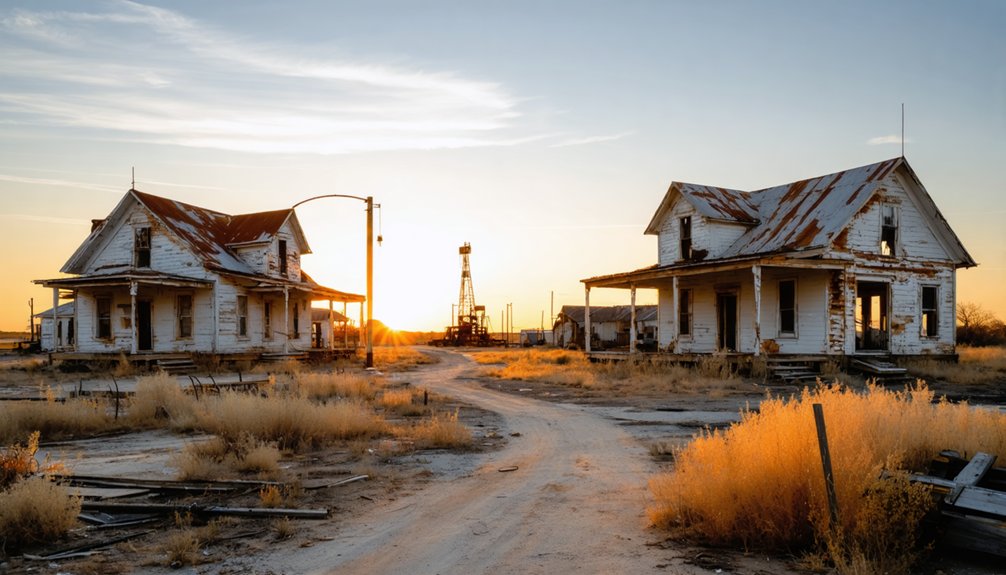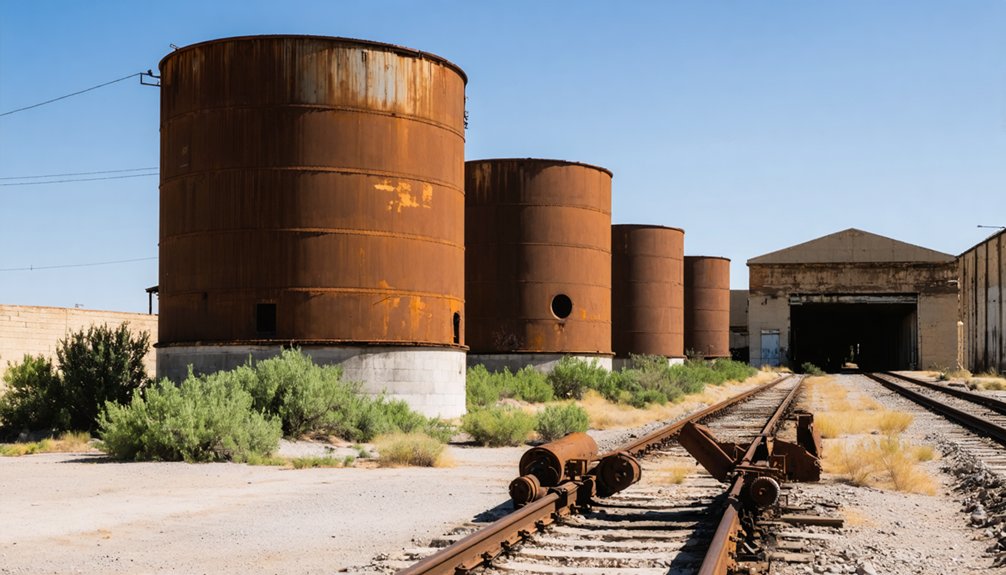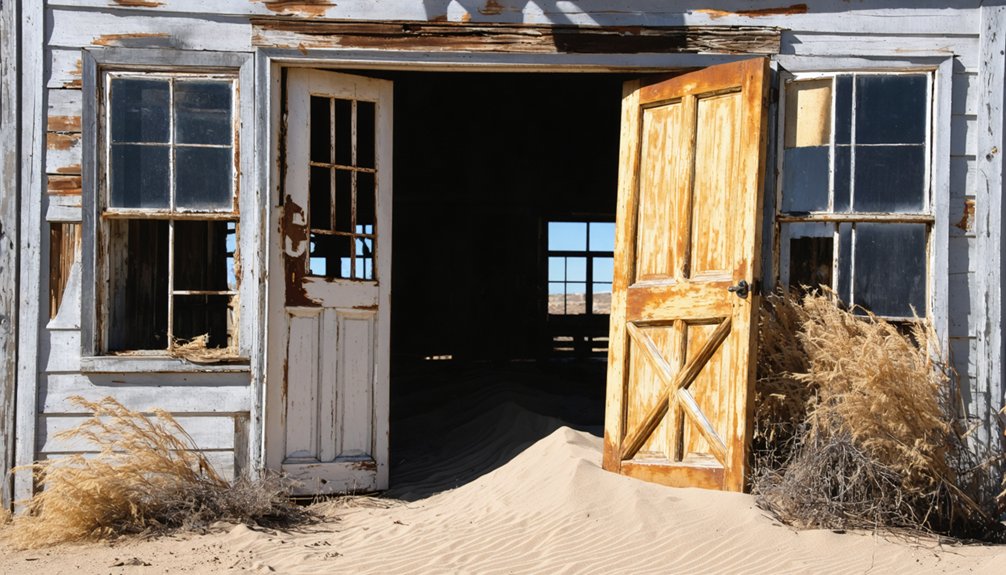You’ll find Texon’s ghost town ruins 50 miles southwest of San Angelo, Texas. This once-thriving oil company town emerged after the Santa Rita No. 1’s historic 1923 discovery, growing to 1,200 residents by 1933. Unlike typical boomtowns, Texon boasted planned neighborhoods, modern amenities, and extensive recreational facilities. Today, fewer than 10 residents remain, with abandoned structures and the historic baseball field telling tales of Texas’ petroleum prosperity.
Key Takeaways
- Texon transformed from a thriving oil boomtown with 1,200 residents in 1933 to a ghost town with fewer than 10 residents by 1990s.
- The town’s decline began post-World War II as oil production decreased and ownership changes led to reduced community investment.
- Abandoned structures including a school, hospital, and historic baseball field remain as physical evidence of Texon’s former prosperity.
- Unlike typical chaotic boomtowns, Texon was planned with modern amenities, organized neighborhoods, and extensive recreational facilities.
- The town’s original layout south of railroad tracks still exists, serving as a testament to Texas’s petroleum boom-and-bust cycle.
The Birth of a Model Oil Company Town
When oil erupted from the Santa Rita #1 well on May 28, 1923, it marked the birth of what would become Texon, Texas – a pioneering model company town in the Permian Basin.
After Texon Oil and Land Company‘s initial discovery, Pittsburgh oilmen M.L. Benedum and Joe Trees acquired the leases and formed Big Lake Oil Company.
Under BLOC president Levi Smith’s vision, you’d find a different kind of oil boom settlement taking shape from 1924 to 1926.
Unlike the chaotic boomtowns of the era, Texon was carefully planned south of the Kansas City, Mexico and Orient Railway.
Smith’s blueprint called for proper housing, schools, and medical facilities from the start.
Located 85 miles west of San Angelo, the town became a landmark in Reagan County’s oil development.
You’d see private businesses operating in company-owned buildings, creating a self-sustaining community that stood apart from typical rough-and-tumble oil camps.
By 1933, the thriving community reached its peak with a population of 1,200 residents.
Life in Texon’s Golden Years
During its peak years in the 1930s, Texon thrived as more than just another dusty West Texas oil camp – it stood as a model of planned community living in the Permian Basin.
You’d find distinct neighborhoods reflecting clear labor relations: administrative staff in two-bedroom homes, hourly workers in shotgun houses, all maintained by BLOC.
Unlike typical boomtowns, you’d enjoy modern amenities like running water, electricity, and sewage systems.
Texon defied the crude conditions of oil boomtowns by offering its residents the civilized comforts of modern infrastructure.
The community dynamics centered around the Texon Oilers baseball games, company barbecues, and gatherings at the theater, pool, or golf course.
You could shop at local businesses, see a doctor at the hospital, or send your kids to the company-built school.
Big Lake Oil Company founder Levi Smith deliberately created this well-ordered community to ensure stability for employees.
This structured yet comfortable lifestyle helped Texon maintain a stable population of 1,200 residents while avoiding the lawlessness common to other oil settlements.
The town’s prosperity was largely due to the Santa Rita well, which set records as the world’s deepest oil well at 8,525 feet in 1928.
Community Amenities and Social Infrastructure
Life in Texon revolved around an extensive network of company-provided amenities that set it apart from typical oil boomtowns. You’d find everything from basic necessities to recreational activities, including a hospital staffed with both a physician and dentist, a grade school for workers’ children, and various retail shops along the main street.
Community gatherings centered around the town’s impressive recreational facilities. You could catch a game of the semi-professional Texon Oilers baseball team, cool off in the swimming pool, or enjoy a round of golf. The theater, tennis courts, and parks provided additional venues for social connection.
Essential services included natural gas heating, electricity from company generators, and public bathhouses. While most facilities were company-owned and operated, they created a self-sufficient, family-oriented atmosphere that made Texon a model oil community.
The Santa Rita Well Legacy
You’ll find that Santa Rita No. 1‘s discovery in 1923 forever changed West Texas by confirming vast petroleum reserves across the 75,000-square-mile Permian Basin.
The well’s success drew oil company scouts and local residents to the region, launching an economic transformation that would establish Texas as an energy powerhouse. Led by Carl Cromwell’s crew, the drilling operation persevered for two years until striking oil at 3,050 feet. The well initially sprayed oil over a 250-yard area when it first roared to life.
The discovery also created the Permanent University Fund through mineral rights on University of Texas lands, providing critical funding for Texas higher education that continues today.
Discovery Changed West Texas
Three historic events converged in West Texas during the early 1920s to forever change the region’s destiny: Rupert Ricker’s initial lease acquisition of 430,000 acres, Frank T. Pickrell’s purchase of those rights, and the discovery of oil at Santa Rita No. 1.
You’ll find that this convergence sparked an unprecedented economic transformation across the Permian Basin.
When oil exploration struck success on May 28, 1923, at 3,050 feet deep, it launched a boom that would redefine West Texas.
You can trace the region’s dramatic evolution through the rapid development that followed – new jobs flooded the area, infrastructure expanded, and communities grew.
The University of Texas system flourished from the oil royalties, receiving its first payment in August 1923.
This discovery didn’t just strike oil; it struck gold for Texas’s future.
The Santa Rita No. 1 well continued producing oil for an impressive 70 years, making it one of the most significant discoveries in Texas history.
After decades of weathering, the site underwent a major restoration project to preserve its historical significance for future generations.
Pioneering Permian Basin Development
After Rupert Ricker secured the initial lease rights to 431,360 acres of University lands in 1919, the path to discovering West Texas oil proved challenging.
When he couldn’t raise the $43,136 filing fee, he sold his rights to Frank Pickrell and Haymon Krupp for $2,500. These Army veterans formed Texon Oil and Land Company, launching innovative financing through stock sales to fund their oil exploration dreams.
You can trace Texon’s history to the moment they hired Carl Cromwell, who drilled for 646 days before striking oil on May 28, 1923. The discovery produced an initial flow of oil between 30 and 100 barrels per day.
The Santa Rita No. 1 well‘s success transformed the Permian Basin into America’s largest oilfield. The discovery well initiated a revenue stream that has generated over $10.7 billion for Texas universities.
Today, you’ll find the original drilling rig preserved at the University of Texas at Austin, a reflection of the pioneering spirit that opened West Texas oil development.
Baseball, Recreation, and Entertainment

During Texon’s heyday as a model oil town, baseball stood at the center of community life, with the semi-professional Texon Oilers drawing crowds and pride to their games. Sponsored by Big Lake Oil Company president Levi Smith, the team consisted mainly of company employees and proved their competitive spirit by defeating the House of David teams in 1934, ending their two-year winning streak.
This baseball culture strengthened community identity in ways that extended far beyond the diamond.
You’d have found plenty of other entertainment options too. The town boasted impressive amenities including a golf course, tennis courts, swimming pool, bowling alley, and theater.
These facilities weren’t just about fun – they helped retain workers and their families while distinguishing Texon from other rougher oil boom towns in the region.
Economic Prosperity and Peak Years
When the Santa Rita #1 well struck oil in May 1923, it transformed Texon from empty ranchland into a thriving economic powerhouse. The oil boom sparked rapid community growth as Pittsburgh wildcatters Benedum and Trees formed Big Lake Oil Company, bringing infrastructure and prosperity to the region.
By 1933, you’d find 1,200 residents enjoying a well-planned town with modern amenities and diverse businesses.
- The town’s family-focused approach set it apart from typical oil camps, offering two-bedroom houses for administrators and one-bedroom homes for hourly workers.
- Local entrepreneurs operated businesses from company-built structures, including a dairy, drugstore, and service station.
- Community planning prioritized quality of life with tennis courts, a golf course, swimming pool, and grade school.
The Post-War Transformation

The prosperous days of Texon began to fade as World War II drew to a close, with the Big Lake Oil Field‘s declining production triggering a chain of transformative events.
As oil production waned in post-war Texon, the once-thriving boomtown faced an irreversible decline that would reshape its destiny forever.
You’d have witnessed a dramatic population decline from over 1,000 residents to mere double digits as jobs vanished and workers sought opportunities elsewhere.
While the Big Lake Oil Company maintained Texon’s model town status until 1956, the workforce shift became unavoidable.
Plymouth Oil’s takeover marked the beginning of the end, followed by Marathon Oil’s acquisition in 1962.
When Marathon withdrew its support, the town’s decline accelerated rapidly.
Essential services disappeared one by one – stores closed, the theater went dark, and the swimming pool emptied.
Even the post office, Texon’s last official service, wouldn’t survive past 1986.
From Bustling Hub to Abandoned Town
After discovering oil in the Permian Basin in 1923, Texon quickly blossomed into a thriving community under the Texon Oil and Land Company’s guidance.
During the oil boom, the town’s population surged to 1,200 residents by 1933, supporting a robust infrastructure with stores, schools, and even a baseball team.
The community decline began as oil production waned after World War II.
When ownership changed hands from Big Lake Oil to Plymouth Oil, and later to Marathon Oil, each company showed less interest in maintaining the town’s significance.
By the mid-1990s, fewer than 10 residents remained.
- Environmental damage from wastewater severely impacted the surrounding landscape
- The post office’s closure in 1986 marked the end of essential services
- Failed economic diversification left the town vulnerable to abandonment
Physical Remnants and Historical Markers

Modern-day visitors to Texon encounter only sparse remnants of its once-bustling oil town glory.
Abandoned oil towns like Texon stand as ghostly monuments to the boom-and-bust cycle of petroleum prosperity.
You’ll find just one or two inhabited homes standing among the ruins of what was a model company town. The abandoned shells of a school, hospital, and theater hint at the community’s former liveliness, while a historic baseball field sits silent in the desert air.
You can’t miss the environmental scars that tell Texon’s industrial story. The lasting impact of 1920s oil wastewater dumping remains visible in the landscape and stunted vegetation.
While physical structures have largely crumbled, the town’s original layout south of the railroad tracks persists, and scattered foundation remnants mark where fuel stations and utility buildings once served this pioneering Permian Basin settlement.
Texon’s Impact on Texas Oil History
When Santa Rita #1 struck oil in May 1923, it launched both Texon’s existence and West Texas’ petroleum era.
You’ll find Texon’s influence reaching far beyond its planned community borders, as it helped establish the Permian Basin as one of the world’s most productive oil regions.
The town’s unique community dynamics challenged the typical oil boomtown stereotype, proving that oil exploration didn’t have to mean chaos and disorder.
- Texon’s model community approach influenced future company towns across Texas, setting higher standards for worker welfare.
- The Big Lake oilfield discovery sparked widespread petroleum development that transformed West Texas’ economy.
- Your freedom to explore Texas’ oil potential today stems from the risks taken by Texon’s early wildcatters and visionaries.
Frequently Asked Questions
What Happened to the Displaced Residents After Texon Became a Ghost Town?
Like tumbleweeds in the wind, displaced families scattered across Texas after Texon’s decline, facing relocation challenges as they searched for new oil jobs in neighboring towns and cities.
You won’t find documented oral histories from living Texon residents sharing their stories publicly today. With fewer than ten residents remaining by 1996, most resident memories have unfortunately been lost to time.
Was Texon Ever Featured in Any Movies or Television Shows?
No, you won’t find any Texon film or television appearances in Hollywood’s digital archives. Research shows this independent-minded Texas ghost town never made it onto the silver or small screen.
Can Visitors Legally Explore the Remaining Ruins of Texon Today?
You’ll need explicit landowner permission for legal exploration since most ghost town regulations classify Texon as private property. Without documented access rights, you can’t legally enter the ruins.
Did Any Notable Historical Figures or Celebrities Ever Visit Texon?
Picture a remote oil town, where derricks pierce the sky. You won’t find records of any famous visitors or celebrities in Texon’s past – its historical significance stems purely from its oil industry legacy.
References
- https://www.county.org/county-magazine-articles/summer-2025/ghost-towns
- https://www.youtube.com/watch?v=chI0O2VvGTI
- https://www.ghosttowns.com/states/tx/texon.html
- https://www.tshaonline.org/handbook/entries/texon-tx
- http://genealogytrails.com/tex/hillcountry/reagan/towns.html
- https://www.texasstandard.org/stories/best-texas-the-ghost-town-with-the-worst-reputation/
- https://www.texasescapes.com/TOWNS/Texas_ghost_towns/Texon_Texas/Texon_Texas.htm
- https://en.wikipedia.org/wiki/Texon
- https://pboilandgasmagazine.com/a-company-town-for-the-ages/
- https://kids.kiddle.co/Texon



